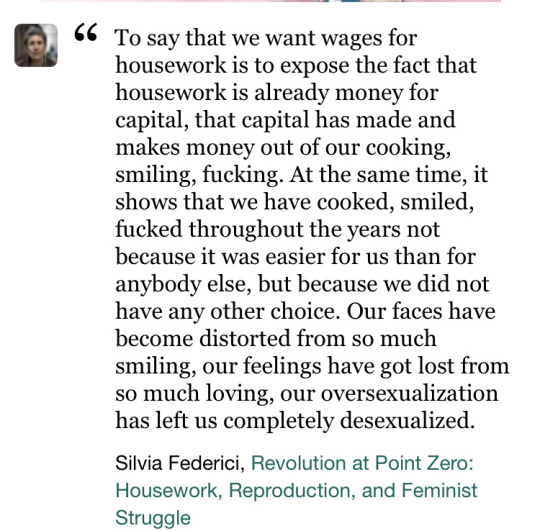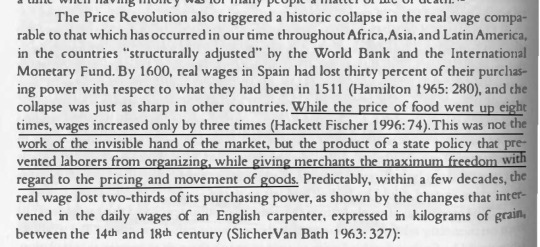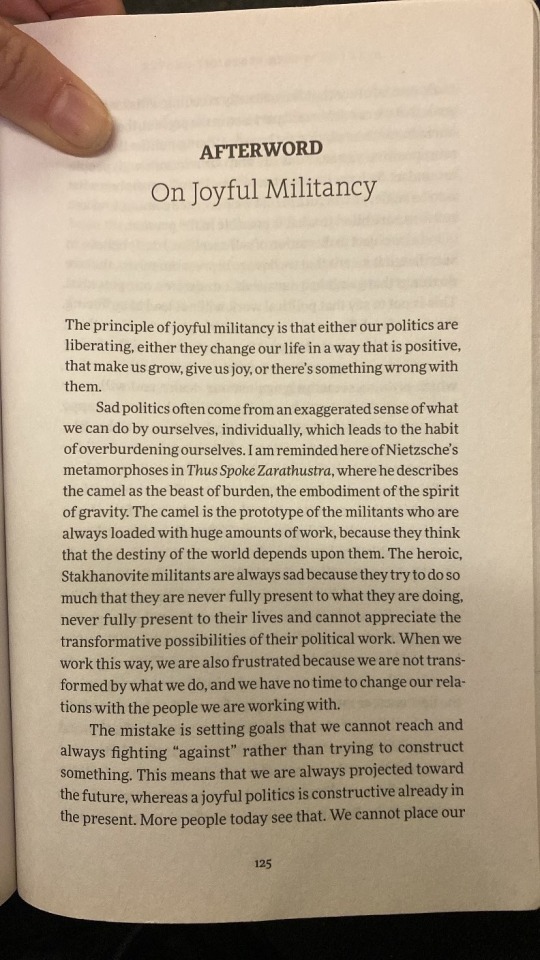#silvia federici
Text
Why procreation should be "a fact of nature" rather than a social, historically determined activity, invested by diverse interests and power relations, is a question Marx did not ask. Nor did he imagine that men and women might have different interests with respect to child-making, an activity which he treated as a gender-neutral, undifferentiated process.
In reality, so far are procreation and population changes from being automatic or "natural" that, in all phases of capitalist development, the state has had to resort to regulation and coercion to expand or reduce the work-force. This was especially true at the time of the capitalist take-off, when the muscles and bones of workers were the primary means of production. But even later — down to the present — the state has spared no efforts in its attempt to wrench from women's hands the control over reproduction, and to determine which children should be born, where, when, or in what numbers. Consequently, women have often been forced to procreate against their will, and have experienced an alienation from their bodies, their "labor," and even their children, deeper than that experienced by any other workers. No one can describe in fact the anguish and desperation suffered by a woman seeing her body turn against herself, as it must occur in the case of an unwanted pregnancy.
—Silvia Federici, "Caliban and the Witch: Women, the Body and Primitive Accumulation".
#silvia federici#marxist feminism#feminism#marxism#radical feminism#radblr#patriarchy#women's liberation#proletarian feminism
651 notes
·
View notes
Text
But as surrogate mothering is normalized, it is crucial to highlight the classist and racist premises on which it is founded and its destructive consequences for the children thus produced and for women. A worrisome one is the presence of a number of “suspended children,” who, having been denied, for various reasons, legal certification in the countries where the “intended” parents reside, or having been born with disabilities, are rejected by both the surrogate mother and the commissioning couple. A Reuters investigative report has also found that through the internet adoptive parents, at least in the US, can dispose of children adopted abroad, without any difficulty, through a practice called “private rehoming” that is totally unregulated. Even more worrisome is the evidence that some surrogate children are channeled to the organs market, for once the transaction has taken place no institutional oversight checks what happens to the children marketed this way, who in most cases are taken to other regions, thousands of miles away from the place of their birth. ...
While defenders portray it as a humanitarian gesture, a gift of life enabling couples who cannot have children to experience the joys of parenting, the fact is that it is women from the poorest regions of the world who generally take on this task, and surrogacy would not exist except for the monetary compensations it fetches. Quite properly, then, in “Surrogates and Outcast Mothers: Racism and Reproductive Politics in the Nineties” (1993), Angela Davis has argued that surrogacy is continuous with the breeding practices that were enforced on the American slave plantations, with poor women in both cases being destined to forfeit their children, once born, for the profit of the rich.
-- Silvia Federici, "Surrogate Motherhood: A Gift of Life or Maternity Denied?" in Beyond the Periphery of the Skin
88 notes
·
View notes
Text
"Performance flattens the content of social action, suggesting that the only alternatives open to us are consent or dissent, thereby underestimating the rebellion brewing in many acts of consent--the many forms of sabotage built under our apparent yessing the system, which under particular historical conditions, can turn into powerful movements."
Beyond the Periphery of the Skin: Rethinking, Remaking, and Reclaiming the Body in Contemporary Capitalism - Silvia Federici (2020)
58 notes
·
View notes
Text
“Capitalism makes acquisition "the ultimate purpose of life," instead of treating it as a means for the satisfaction of our needs; thus, it requires that we forfeit all spontaneous enjoyment of life. Capitalism also attempts to overcome our "natural state," by breaking the barriers of nature and by lengthening the working day beyond the limits set by the sun, the seasonal cycles, and the body itself, as constituted in pre-industrial society.”
— Silvia Federici
#silvia federici#caliban and the witch#marxist feminism#marxism#capitalism#socialism#liberation#quote
84 notes
·
View notes
Text
What are the driving forces behind this development, and what does it tell us about the transformations that are taking place in the global economy and in the social position of women? Answers to these questions have varied, but it is my objective to demonstrate that, while this new surge of violence takes different forms, a common denominator is the devaluation of women’s lives and labor that globalization promotes. In other words, the new violence against women is rooted in structural trends that are constitutive of capitalist development and state power as such, in all time periods.
Capitalist development begins with a war on women. The witch hunts of the sixteenth and seventeenth centuries in Europe and the New World led to the deaths of thousands. As I wrote in my 2004 book Caliban and the Witch, this historically unprecedented phenomenon was a central element of the process that Marx defined as primitive accumulation, for it destroyed a universe of female subjects and practices that stood in the way of the nascent system’s main requirements: the accumulation of a massive workforce and the imposition of a more constraining discipline of labor. The naming of women as witches and the persecution of them for their witchcraft paved the way for the confinement of women in Europe to unpaid domestic labor. It legitimated their subordination to men in and beyond the family. It gave the state control over their reproductive capacity, guaranteeing the creation of generations of new workers. In this way, the witch hunts constructed a specifically capitalist, patriarchal order that has continued into the present, though it has been constantly adjusted in response to women’s resistance and the changing needs of the labor market.
From the tortures and executions to which women accused of witchcraft were subjected, other women soon learned that they would have to be obedient and silent, and would have to accept hard labor and men’s abuses, in order to be socially accepted. Until the eighteenth century, those who fought back might be condemned to the “scold’s bridle,” a metal and leather contraption, also used to muzzle slaves, that enclosed the wearer’s head and, if she attempted to speak, lacerated her tongue. Gender-specific forms of violence were also perpetrated on American plantations where by the eighteenth century (per Ned Sublette and Constance Sublette’s 2015 study The American Slave Coast) masters’ sexual assaults on female slaves had turned into a systematic politics of rape, as planters attempted to replace the importation of slaves from Africa with a local breeding industry centered in Virginia.
Violence against women did not, of course, disappear with the end of the witch hunts or with the abolition of slavery. On the contrary: It was normalized. The sterilization of women of color, poor women, and women who practiced their sexuality outside marriage continued into the 1960s. Similarly, until feminists forced its recognition, rape in the family did not exist, as far as the state was concerned. As Giovanna Franca Dalla Costa pointed out in Un lavoro d’amore (The Work of Love, 1978), violence has always been present as a subtext, a possibility, in the nuclear family, because men, through their wages, have been given the power to supervise women’s unpaid domestic labor, to use women as their servants, and to punish their refusal of this work. This is why domestic violence perpetrated by men was, until recently, not considered a crime. In parallel with the state’s legitimation of parents’ right to punish their children, who must be trained in obedience so that they’ll be tractable workers, domestic violence against women was tolerated by the courts and the police as a legitimate response to women’s noncompliance in their domestic duties.
It’s essential to emphasize that violence against women is a key element in this new global war not only because of the horror it evokes or the messages it sends, but also because of what women represent in their capacity to keep their communities together and, equally importantly, to defend noncommercial conceptions of security and wealth. In Africa and India, for instance, until recently, women had access to communal land and devoted a good part of their workday to subsistence farming. But both communal land tenure and subsistence agriculture have come under heavy institutional attack, criticized by the World Bank as one of the causes of global poverty, the argument being that land is a “dead asset” unless it is legally registered and used as collateral to obtain bank loans with which to start some entrepreneurial activity.
#marxism-feminism#women's rights#Silvia Federici#VIOLENCE AGAINST WOMEN#femicide#primitive accumulation
8 notes
·
View notes
Text

well,
(Wages Against Housework [pdf], Silvia Federici)
16 notes
·
View notes
Text

#feminism#gender#misandry#wages for housework#wages against housework#silvia federici#feminist philosophy#marxist feminism#women’s strike#general strike#heterorealism#dating culture#heteropessimism
51 notes
·
View notes
Text
Revolution at Point Zero: Housework, Reproduction, and Feminist Struggle (Silvia Federici, 2012)
WAGES AGAINST HOUSEWORK (1975)
"We must admit that capital has been very successful in hiding our work. It has created a true masterpiece at the expense of women.
By denying housework a wage and transforming it into an act of love, capital has killed many birds with one stone.
First of all, it has gotten a hell of a lot of work almost for free, and it has made sure that women, far from struggling against it, would seek that work as the best thing in life (the magic words: “Yes, darling, you are a real woman”).
At the same time, it has also disciplined the male worker, by making “his” woman dependent on his work and his wage, and trapped him in this discipline by giving him a servant after he himself has done so much serving at the factory or the office.
In fact, our role as women is to be the unwaged but happy and most of all loving servants of the “working class,” i.e., those strata of the proletariat to which capital was forced to grant more social power.
In the same way as god created Eve to give pleasure to Adam, so did capital create the housewife to service the male worker physically, emotionally, and sexually, to raise his children, mend his socks, patch up his ego when it is crushed by the work and the social relations (which are relations of loneliness) that capital has reserved for him.
It is precisely this peculiar combination of physical, emotional and sexual services that are involved in the role women must perform for capital that creates the specific character of that servant which is the housewife, that makes her work so burdensome and at the same time so invisible.
It is not an accident, then, if most men start thinking of getting married as soon as they get their first job.
This is not only because now they can afford it, but also because having somebody at home who takes care of you is the only condition of not going crazy after a day spent on an assembly line or at a desk.
Every woman knows that this is what she should be doing to be a true woman and have a “successful” marriage."
15 notes
·
View notes
Text

"Ir más allá de la piel", de Silvia Federici
#ir mas alla de la piel#silvia federici#feminismo#feminist#feminist books#book#books#girls reading#girl reading#women reading#reading#instabooks#books and girls#girls and books#books & girls#leyendo#literatura#subte#subway#instasubway#books i ve read#bookcover#book haul#bookhaul#bookhunter#bookhunters#bookhunting#currently reading#leo#amo leer
6 notes
·
View notes
Text

Was reading Caliban and the Witch and thought this passage sounded familiar.
30 notes
·
View notes
Text
“Wagelessness and underdevelopment are essential elements of capitalist planning, nationally and internationally. They are powerful means to make workers compete on the national and international labor market, and make us believe that our interests are different and contradictory.
Here are the roots of sexism, racism and welfarism (contempt for the workers who have succeeded in getting some money from the State), which are the expressions of different labor markets and thus different ways of regulating and dividing the working class. If we ignore this use of capitalist ideology and its roots in the wage relation, we not only end up considering racism, sexism and welfarism as moral diseases, products of “false consciousness,” but we are confined to a strategy of “education” that leaves us with nothing but “moral imperatives to bolster our side.””
Silvia Federici | Counterplanning from the Kitchen (1975)
87 notes
·
View notes
Text
For the witch-hunt destroyed a whole world of female practices, collective relations, and systems of knowledge that had been the foundation of women's power in pre-capitalist Europe, and the condition for their resistance in the struggle against feudalism.
Out of this defeat a new model of femininity emerged: the ideal woman and wife — passive, obedient, thrifty, of few words, always busy at work, and chaste. This change began at the end of the 17th century, after women had been subjected for more than two centuries to state terrorism. Once women were defeated, the image of femininity constructed in the "transition" was discarded as an unnecessary tool, and a new, tamed one took its place.
While at the time of the witch-hunt women had been portrayed as savage beings, mentally weak, unsatiably lusty, rebellious, insubordinate, incapable of self-control, by the 18th century the canon has been reversed. Women were now depicted as passive, asexual beings, more obedient, more moral than men, capable of exerting a positive moral influence on them.
—Silvia Federici, "Caliban and the Witch: Women, the Body and Primitive Accumulation".
28 notes
·
View notes
Text
reading Caliban and the Witch makes me realize how massive of an oversight it is not to mention Romani women in feminist theory books.
"Slavery is "that form [of exploitation] towards which the master always strives" (Dockes 1982: 2). Europe was no exception. This must be emphasized to dispel the assumption of a special connection between slavery and Africa. But in Europe slavery remained a limited phenomenon, as the material conditions for it did not exist, although
the employers' desires for it must have been quite strong if it took until the 18th century before slavery was outlawed in England."
Except that Romani people were enslaved for 500 years in Romania, accounting for 7% of the population of the country by the time of its abolition.
"... the destiny of West European women, in the period of primitive
accumulation, was similar to that of female slaves in the American colonial plantations who, especially after the end of the slave-trade in 1807, were forced by their masters to become breeders of new workers. The comparison has obviously serious limits. European women were not openly delivered to sexual assaults — though proletarian women could be raped with impunity and punished for it. Nor had they to suffer the agony of seeing their clildren taken away and sold on the auction block."
Except that killing Romani people was legal in Western Europe in the 1600s - 1700s and Romani people were systematically jailed by Western European countries at the same, from which we can suppose sexual violence against Romani women was widespread and not punished by the law. There is so much nuance that could be added to the conversation if we could factor in Romani history
15 notes
·
View notes
Text
"No es sorpresa que la violencia contra las mujeres haya sido más intensa en
aquellas zonas del mundo más ricas en recursos naturales (el África Subsahariana, América Latina, el Sudeste Asiático), que ahora son objetivo de empresas comerciales y en las que la lucha anticolonial ha sido más intensa. Vejar a las mujeres es funcional para los «nuevos cercamientos». Allana el camino al acaparamiento de tierras, las privatizaciones y las guerras que llevan años devastando regiones enteras".
-Brujas, caza de brujas y mujeres. -Silvia Federici
2 notes
·
View notes

